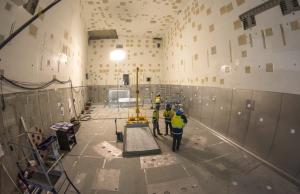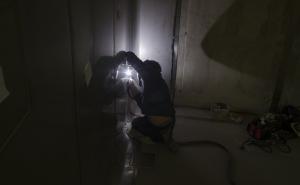Tokamak Building
The many mirrored room
29 Jan 2018
It's a strange place—a room that could easily accommodate a three-storey building, a star-studded firmament (except these stars are all square), and tall sheets of stainless steel installed on the lower walls. In a few weeks, the floor will receive the same treatment and the place will soon shine like a mirror.
In case of a leak in the tanks, the steel lining will act as a "drip pan" to contain contaminated effluents within the room.
Welcome to the drain tank room: 40 metres long, 15 metres wide, and 11 metres high. Located in the lowest basement level (B2) of the Tokamak Complex, the room will accommodate seven large steel containers with volumes ranging from 100 to 210 cubic metres. These water storage tanks are required for normal operation, as well as for the recovery of water from the tokamak cooling water system or the vacuum vessel pressure suppression system in accidental situations.
Like in other areas of the Tokamak Complex, the constellations on the ceiling of this room are formed by the complex arrangement of embedded plates. There are dozens of them, deeply anchored in the reinforced concrete and precisely positioned in order to anchor piping and equipment.
The steel lining on the floor and lower walls is more unusual (1). It will ensure that, in the event of a leak in one of the tanks, contaminated effluents will remain contained within the room.
The 4-millimetre thick steel sheets need to be adjusted and welded with utmost precision in order to ensure leak tightness.
The workers from SEMA, the VFR contractor that is responsible for the installation of the lining, call it a "drip pan" because it acts like the tray one places under roasting meat to collect the drippings.
The lining on the walls is made of 4-millimetre-thick stainless steel sheets that measure 3 metres in height and 1.4 metres in width. Openings need to be cut into most of the sheets to allow access to the embedded plates, and all the sheets need to be adjusted and welded with utmost precision in order to ensure leak tightness. The same procedure will be used to line the 600 square metres of the floor.
Every weld will be checked individually using a number of techniques. One is both sophisticated and simple—a vacuum box containing soapy water that is applied along the weld lengths. In the case of an air leak, bubbles will form.
SEMA began installing the lining in October and the whole "drip pan" should be completed in May.
(1) Cells in the Tritium Building will also be lined with stainless steel.



